PAC-MAN
As long as video arcades meant war games, many women watched white men played. Pac-Man changed that. First released in 1981 by Midway Manufacturing Company, a Bally company, Pac-Man quickly placed in the top ten arcade games and stayed there tor an unprecedented 14 months. Midway acknowledges that the game's success is due to the huge numbers of women who play Pac-Man.
Video experts believe that Pac-Man's lighthearted graphics, catchy tunes and the absence of exploding spaceships attract women players. The game stars a little yellow figure who is being pursued through a maze by four monsters who want to eat him up. Pac-Man earns points by eating dots and power pills that enable him to gobble up the monsters. Bonus points appear as fruit.
Pac-Man's popularity (and record earnings) have prompted competitors to come out with similar games, such as Atari's Jawbreaker. The list of spin-offs is long. The game has inspired a book, a monthly newsletter, home and tabletop versions, a board game, wristwatch, puzzle and record album.
Last spring, Midway expressed its gratitude to its women customers by introducing Ms. Pac-Man, a more challenging version of the original game. The "new femme fatale" of the video world looks like her mate but has long eyelashes and wears a hair ribbon. This version has a three-act, between-game cartoon series that tells the tale of Mr. and Ms.
Pac-Man's courtship and marriage and concludes with the arrival of Pac-Baby by stork. Ms. Pac-Man already has become one of the top five arcade money earners. An animated TV series featuring the Pac-Man family's adventures aired this September on ABC Television.
As with all video games, Pac-Man's popularity is bound to wane. But the game's legacy, for better or worse, will linger on—women now crowd the video arcades and have begun to play the war games too.
—Jennifer Smith

A million dollar idea
